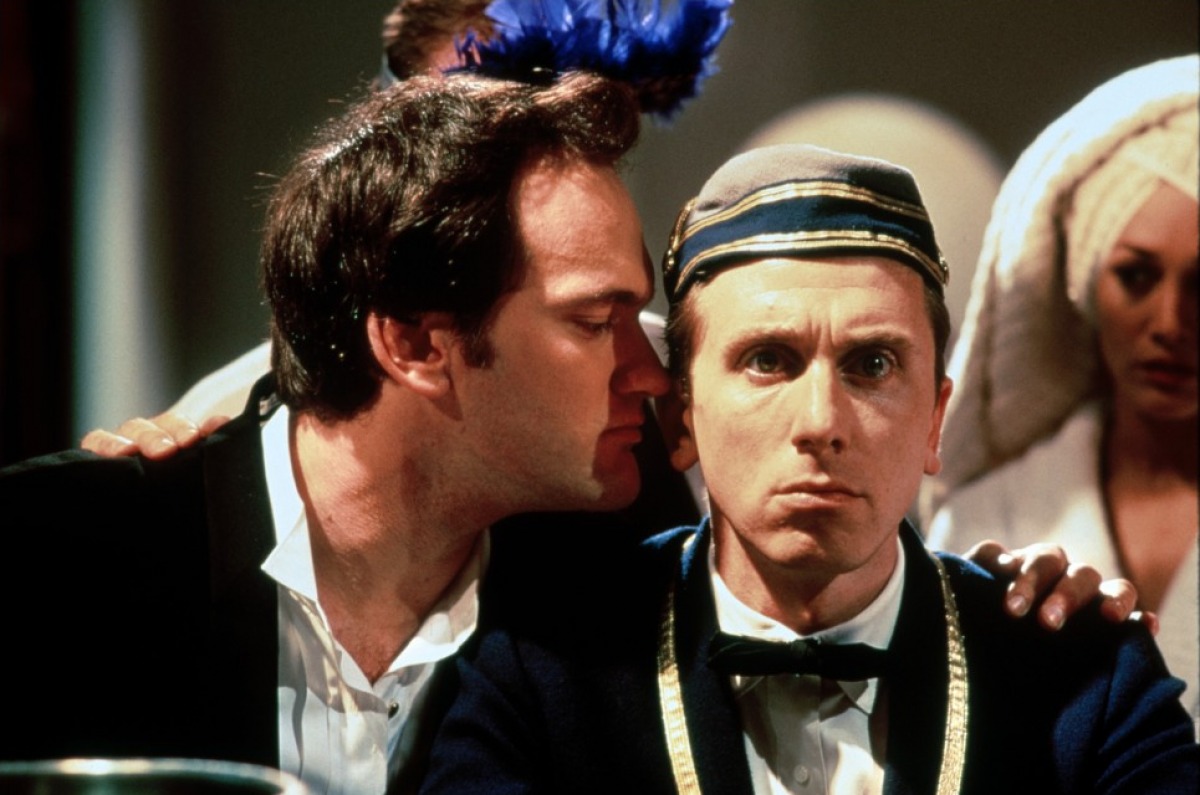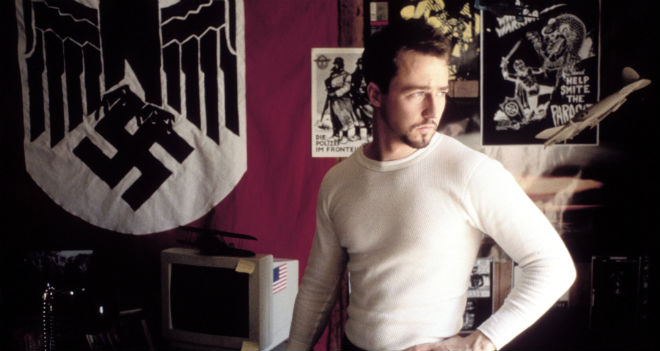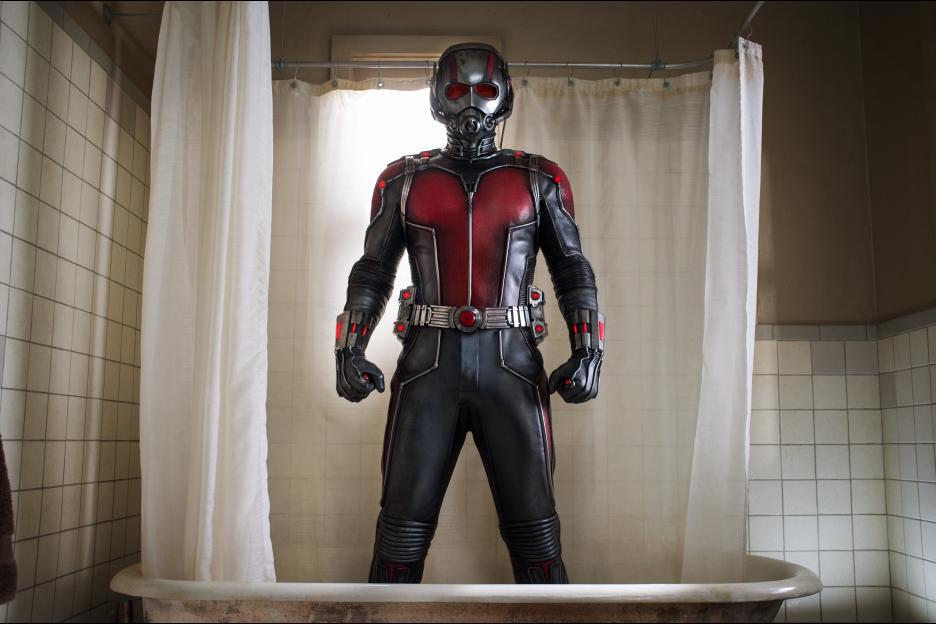4. Quentin Tarantino – Four Rooms (1995)

General consensus states that of Tarantino’s filmography, the red-headed step-child would be 2007’s ‘Death Proof’, one that Tarantino himself referred to as a ‘left-handed movie’ during his Director’s Roundtable Interview. In his right-handed filmography however, Tarantino has always been above all else an expert in captivation, and the way he achieves this in his post-‘Reservoir Dogs’ career is through the blending of genre.
To understand Tarantino is to understand genre, and how he dismantles and reassembles them with frenetic enthusiasm. When Tarantino blends genre, typically indulgent levels of violent action and gore with sprinkles of comedy & pop culture references are hung on to different frameworks, and the result is often met with universal acclaim.
Typically, the whole will add up to more than the sum of its parts. And that is Tarantino in a nutshell. But shortly after he honed this style with his 1994 magnum opus ‘Pulp Fiction’, there was ‘Four Rooms’, an ensemble 1995 comedy in which there was an episode Tarantino wrote, directed and starred in, playing a fast-talking, budding movie director in the most thinly-veiled effigy of a director to date. So why has it been all but buried? Where Tarantino will voice his quibbles with ‘Death Proof’, ‘Four Rooms’ doesn’t receive any acknowledgement whatsoever.
The simplest explanation is that it’s an ensemble piece and rather than outright disown the movie he merely opts to not discuss it, after all he has done similar work writing and directing a segment in Rodriguez’s ‘Sin City’. And with any other writer/director this would be a fair assessment but looking at the marketing campaign for his movies, it becomes clear how finicky Tarantino is about what qualifies his filmography.
‘Four Rooms’ is apparently such a blemish on this that he passively discredits it by naming ‘Kill Bill’ and ‘Death Proof’ as the fourth & fifth film by Quentin Tarantino respectively, retroactively selecting ‘Reservoir Dogs’, ‘Pulp Fiction’ and ‘Jackie Brown’ as his only contributions to cinema in the 90’s.
As many already know, both of these ostensibly singular entries were actually comprised of two films – ‘Kill Bill Vol. 1 & 2’ and ‘Grindhouse: Death Proof & Planet Terror’ and it is here where Tarantino’s internal logic all but breaks down. In the former case, both films add up to one entry. By that logic, ‘Death Proof’ and ‘Planet Terror’ together would make up one entry too. But Tarantino knowingly bills ‘Death Proof’ as the fifth entry to his filmography, in spite of it structurally being the first half of a two-part series.
If this is confusing, then it’s really owed to Tarantino’s own inconsistency and all the while this ignores the patent fact that audiences are paying the price of a movie ticket for any one of these entries, ‘Four Rooms’ included. So despite his recent ‘The Hateful Eight’ being billed as his eighth feature, the price audiences pay have closer bearing to what constitutes a Tarantino film, making it something like entry number nine-and-a-half instead.
All of this is indicative that if ‘Four Rooms’ doesn’t merit a mention then Tarantino hopes to expunge it from existence, and until he discusses it the reasons will remain unclear, but an educated guess traces back to our understanding of Tarantino and genre. Screenwriting guru Robert McKee once said that a successful screenwriter must ‘know his genre’, and whether you like him or not, Tarantino knows genre.
But since his real talent lies in the mixing of genre, ‘Four Rooms’ plays as a straight comedy and with the minor exception of brief gore-less violence at the end, it is a straight comedy only. So as a Tarantino movie with one genre to play with, the whole is neither more nor less than the sum of its parts so much as it is one part in search of other parts to make up a whole.
Tarantino at his best can be garishly funny, but without the framework of another genre to hang that on the result is something like ‘Four Rooms’. It isn’t bad, but relative to his other work it feels incomplete, though he wouldn’t admit it directly, for that would let people know it exists at all. Tarantino as understood by the masses is an enormous movie fan who has always indulged in all genres across all film eras regardless of their quality, so with that attitude in mind, ‘Four Rooms’ should be compulsory viewing, middling quality notwithstanding. After all, it is what Quentin Tarantino ‘the movie fan’ would do.
5. Tony Kaye – American History X (1998)

Of all the entries on this list, there is no bigger disparity between the film and its maker than Tony Kaye’s ‘American History X’. On one hand, ‘American History X’ is both widely known and revered (and deservedly so) while on the other hand its creator, Tony Kaye is virtually unknown since after this sole Hollywood entry he wilfully divorced himself from this and all future Hollywood projects, retreating back to his familiar territory of shorts and documentaries that he continues to make as of 2017.
‘American History X’ opened in the tail end of the 90’s to polarizing reviews but received overwhelmingly positive approval from audiences who did not see its brutal depiction of heated race relations as operatic or of surface verisimilitude as suggested by critics of the time.
The reason it endures now is thanks in part to its pure depiction of the timeless ‘fall from grace to redemption’ character arc that sees protagonist Derek Vinyard’s punishing journey through and out of Neo-Nazi indoctrination by way of misdirected resentment and budding intelligence, and the movie accomplishes this while underpinning themes of race relations, socio-political hierarchy, and class warfare without any aspect feeling like an afterthought.
On top of which it is an utterly unflinching film that subjects its audience to merciless race-related attacks including the use of bleach, firearms, gang-rape and one infamous curb-stomp (which to those unaware of the movie is exactly what it sounds like).
And the movies creator, Tony Kaye, hates it. Rather, he hates what Edward Norton did to his work.
Movies are all made in the editing, and after shooting wrapped Tony Kaye like most directors, requested final cut of the picture. After some rebuttals from the studio, this request turned into demand, which along with his self-confessed penchant for melodrama resulted in him being strong-armed out of the editing suite by the then 30lbs-of-muscle-heavier Edward Norton. Norton and the studio would go on to finish cutting ‘American History X’ without Kaye’s input or approval.
Kaye did not go down without a fight however, with infamous tales of spending $100,000 to submit advertisements against the producers of the movie, as well as launching a long-fought lawsuit against the Director’s Guild of America. Reportedly, their final meeting involved Kaye suggesting his name be replaced with pseudonym Humpty Dumpty, and with that Kaye’s relations with Hollywood executives were left so sour and vitriolic that his time as an A-list Hollywood director was over before it had begun.
For audiences, this is a bittersweet circumstance, since the world lost all future works from the mind that brought us ‘American History X’, yet if Kaye were to be granted the autonomy he desired, there is no telling how the film would have turned out. It’s difficult to ascertain exactly what changes the movie needed from the one we have, and altering it from its current state would run the risk of softening its impact.
Usually this degree of behind-the-scenes drama dooms a product to failure, but despite what critics said at the time, ‘American History X’ stands tall as a heart-wrenching and unapologetic depiction of socio-political issues that no other similarly themed film has matched to date. But it would also unfortunately be the lone insight into the scope of Tony Kaye’s talent. Much to chagrin of Tony Kaye himself.
6. Edgar Wright – Ant-Man (2015)

Since the unearthing of then B-list superhero Iron Man and the subsequent dominance of the superhero genre in the modern climate, the Marvel studio movies are a gargantuan tour-de-force, and as such need to be helmed and maintained by a select group of like-minded business moguls with far-reaching plans if they are to meet projected successes for the planned releases to come in the next decade.
The man at the top of all of this is Kevin Feige, who with his Marvel Studios cohorts are in place to ensure that in spite of the varying storylines and tones across the now 16 Marvel movies, they overall carry with them a degree of cohesion so that when the movies inevitably overlap nothing looks too jarring or out of place. And of course, to make dump-truck loads of money for as long as possible.
So while the individual movies themselves all have different creative forces behind them, ultimately everything must run through Feige’s team at the top in order to be green-lit and therein lies the reason why Edgar Wright was compelled to step down from the Marvel Cinematic Universe Phase 2 swansong ‘Ant-Man’.
The situation at Marvel is that they need directors creative enough to have a voice but submissive enough to tow the line, and despite being so close to the end of production for ‘Ant-Man’, Edgar Wright ultimately refused to stay in that position. This is hardly the first time a studio and director of a Marvel cinematic entry have parted ways due to the ever diplomatic umbrella of ‘creative differences’.
By now people are familiar with the absence of Edward Norton as The Hulk and Terence Howard as War Machine after their first and only entry, but a lesser known example would be Jon Favreau – director of ‘Iron Man’ and the only man who insisted that no-one play the titular hero but Robert Downey Jr. – was also quietly ousted from his directorial position despite pioneering this universe as we know it.
This suggests that good will and pedigree matters little to those at the top of this pyramid because despite Wright remaining the primary creative force behind this instalment, directing credit for ‘Ant-Man’ has been attributed to American comedy director Peyton Reed.
Precisely how much of the movie had been developed at the time of Wright’s departure is anyone’s guess but given Wright’s self-proclaimed heartbreak it is safe to say a lot of his input was bastardized and whichever notes from Marvel that caused him to leave the project were ultimately crowbarred into the final product by Reed.
Those familiar with Edgar Wright may find the reason behind this obvious; Wright has written and directed everything he has ever produced, with his particular staple in visual comedy through a series of quick cuts and sharp editing. Of course, this would seem a perfect fit for a stand-alone introduction movie for a lesser known hero like Ant-Man which given the titular heroes ability to change sizes is ripe for visual comedy, but Feige and the rest of his Marvel cohorts need their directors to tow that line.
As Wright himself put it in a 2017 podcast for Variety, ‘I wanted to make a Marvel movie but I don’t think they really wanted to make an Edgar Wright movie.’ Fortunately for fans, much of his input can still be seen on-screen, with the climax fight aboard a Thomas the Tank Engine toy standing out as an example of his trademark British wit, but despite those flashes of creativity, Wright’s role as director was all too often relegated to figurehead status, and the result meant abandoning the movie altogether and taking his name with it.
Unlike other entries on this list, there was nothing jarring in the final product that suggested any behind-the-scenes drama during the production of ‘Ant-Man’, and when considering the same couldn’t be said for something like Josh Trank’s ‘Fantastic Four’, which was met with similar levels of executive meddling, it is safe to assume it is still Wright’s movie in all but name.
Fortunately for audiences, the result did not see a marked dip in quality in Marvel movies nor did it hamper Edgar Wright’s career, who has since immersed himself in personal pet project ‘Baby Driver’ to great critical and commercial success. ‘Ant-Man’ may not have been quite what everyone involved hoped it would be but everyone came out of it for the better.